XPath execution class. More...
#include <xpath_processor.h>
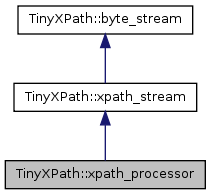

Public Types
Public Member Functions
- xpath_processor (const TiXmlNode *XNp_source_tree, const char *cp_xpath_expr)
- virtual ~xpath_processor ()
- expression_result er_compute_xpath ()
- TiXmlString S_compute_xpath ()
- int i_compute_xpath ()
- bool o_compute_xpath ()
- double d_compute_xpath ()
- unsigned u_compute_xpath_node_set ()
- void v_get_xpath_base (unsigned u_order, const TiXmlBase *&XBp_res, bool &o_attribute)
- TiXmlNode * XNp_get_xpath_node (unsigned u_order)
- TiXmlAttribute * XAp_get_xpath_attribute (unsigned u_order)
Public Attributes
- enum
TinyXPath::xpath_processor:: { ... } e_error
Protected Member Functions
- virtual void v_action (xpath_construct, unsigned, unsigned, const char *)
- virtual int i_get_action_counter ()
- void v_execute_stack ()
- void v_pop_one_action (xpath_construct &xc_action, unsigned &u_sub, unsigned &u_ref, TiXmlString &S_literal)
- void v_execute_one (xpath_construct xc_rule, bool o_skip_only)
- void v_execute_absolute_path (unsigned u_action_position, bool o_with_rel, bool o_everywhere)
- void v_execute_step (int &i_relative_action, bool o_skip_only)
- bool o_check_predicate (TiXmlElement *XEp_child, bool o_by_name)
- void v_execute_function (TiXmlString &S_name, unsigned u_nb_arg, expression_result **erpp_arg)
- void v_function_ceiling (unsigned u_nb_arg, expression_result **erpp_arg)
- void v_function_concat (unsigned u_nb_arg, expression_result **erpp_arg)
- void v_function_contains (unsigned u_nb_arg, expression_result **erpp_arg)
- void v_function_count (unsigned u_nb_arg, expression_result **erpp_arg)
- void v_function_false (unsigned u_nb_arg, expression_result **erpp_arg)
- void v_function_floor (unsigned u_nb_arg, expression_result **erpp_arg)
- void v_function_last (unsigned u_nb_arg, expression_result **erpp_arg)
- void v_function_name (unsigned u_nb_arg, expression_result **erpp_arg)
- void v_function_normalize_space (unsigned u_nb_arg, expression_result **erpp_arg)
- void v_function_not (unsigned u_nb_arg, expression_result **erpp_arg)
- void v_function_position (unsigned u_nb_arg, expression_result **erpp_arg)
- void v_function_starts_with (unsigned u_nb_arg, expression_result **erpp_arg)
- void v_function_string_length (unsigned u_nb_arg, expression_result **erpp_arg)
- void v_function_substring (unsigned u_nb_arg, expression_result **erpp_arg)
- void v_function_sum (unsigned u_nb_arg, expression_result **erpp_arg)
- void v_function_text (unsigned u_nb_arg, expression_result **erpp_arg)
- void v_function_true (unsigned u_nb_arg, expression_result **erpp_arg)
- void v_function_equal (expression_result **erpp_arg)
- void v_function_not_equal (expression_result **erpp_arg)
- void v_function_equal_node_and_other (expression_result *erp_node, expression_result *erp_non)
- void v_function_equal_2_node (expression_result *erp_node_set_, expression_result *erp_node_set_2)
- void v_function_union (node_set &ns_1, node_set &ns_2)
- void v_function_minus (expression_result **erpp_arg)
- void v_function_plus (expression_result **erpp_arg)
- void v_function_or (expression_result **erpp_arg)
- void v_function_and (expression_result **erpp_arg)
- void v_function_relational (expression_result **erpp_arg, unsigned u_sub)
- void v_function_opposite ()
- void v_function_mult (expression_result **erpp_arg, unsigned u_sub)
- void v_order_tree ()
- void v_order_recurs (TiXmlNode *Np_base, int &i_current)
- void v_push_int (int i_val, const char *cp_comment="")
- void v_push_string (TiXmlString S_val)
- void v_push_bool (bool o_val)
- void v_push_double (double d_val)
- void v_push_node_set (node_set *nsp_val)
- bool o_pop_bool ()
- int i_pop_int ()
- TiXmlString S_pop_string ()
- node_set ns_pop_node_set ()
- void v_set_context (TiXmlElement *XEp_in, bool o_by_name)
- const TiXmlElement * XEp_get_context ()
- void v_build_root ()
- void v_remove_root ()
Protected Attributes
- xpath_stack xs_stack
- action_store as_action_store
- TiXmlElement * XEp_root
- Root, above the XML tree given as parameter to the xpath_processor object.
- Root, above the XML tree given as parameter to the xpath_processor object.
- const TiXmlElement * XEp_context
- expression_result er_result
- bool o_is_context_by_name
- const TiXmlNode * XNp_caller_parent
- const TiXmlNode * XNp_caller_prev
- const TiXmlNode * XNp_caller_next
- const TiXmlNode * XNp_base
Detailed Description
XPath execution class.
Member Enumeration Documentation
| anonymous enum |
Constructor & Destructor Documentation
| xpath_processor::xpath_processor | ( | const TiXmlNode * | XNp_source_tree, | |
| const char * | cp_xpath_expr | |||
| ) |
Constructor.
xpath_processor constructor
- Parameters:
-
XNp_source_tree Source XML tree cp_xpath_expr XPath expression
References o_is_context_by_name, XEp_context, and XNp_base.
| virtual TinyXPath::xpath_processor::~xpath_processor | ( | ) | [inline, virtual] |
Member Function Documentation
| expression_result xpath_processor::er_compute_xpath | ( | ) |
Compute an XPath expression.
The executions stack need to contain 1 and only 1 element, otherwize it's not valid
References e_error, er_result, v_build_root(), TinyXPath::xpath_stream::v_evaluate(), v_execute_stack(), v_remove_root(), XEp_root, and xs_stack.
Referenced by d_compute_xpath(), i_compute_xpath(), o_compute_xpath(), S_compute_xpath(), and u_compute_xpath_node_set().
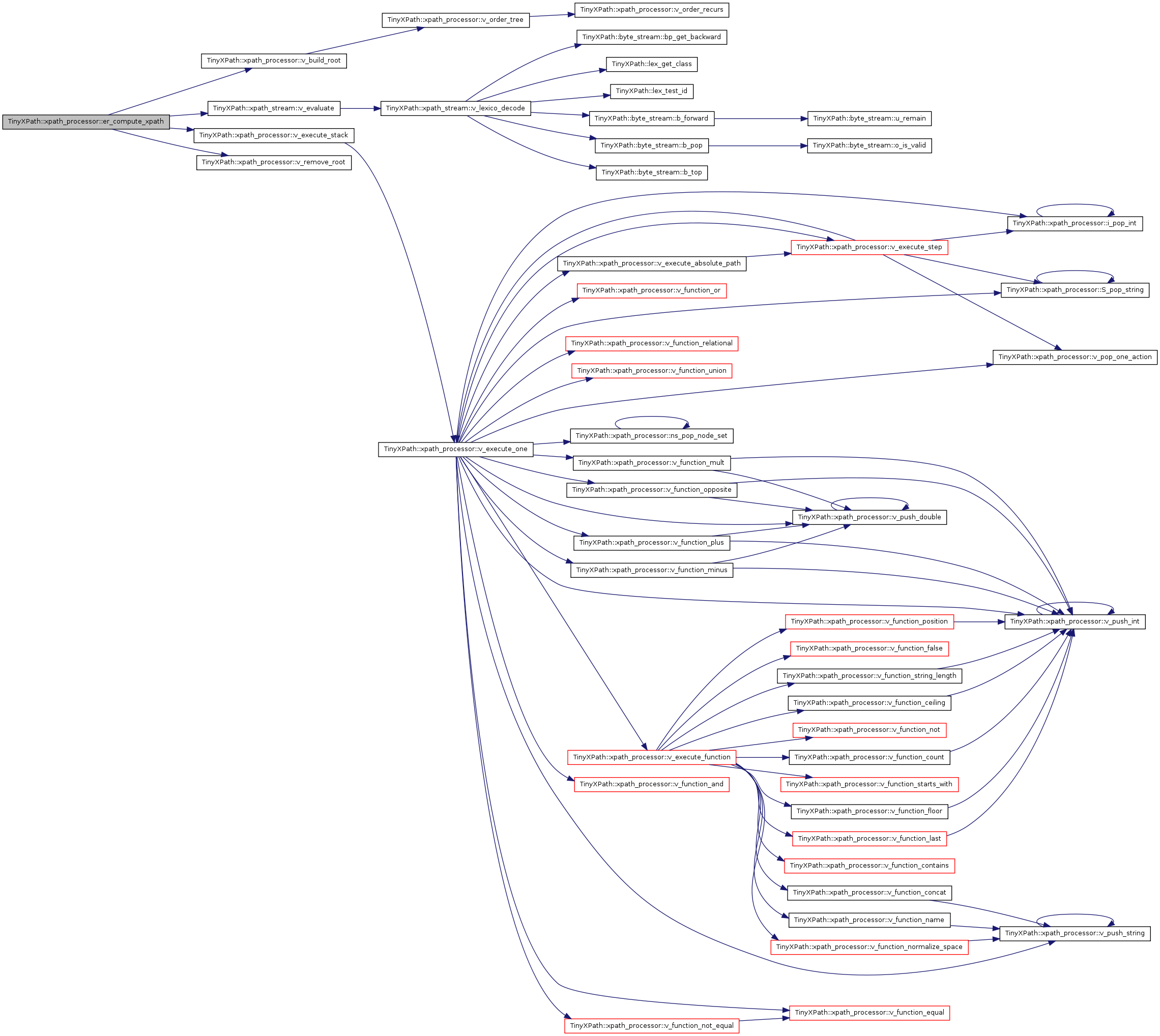

| TiXmlString xpath_processor::S_compute_xpath | ( | ) |
Compute an XPath expression and return the result as a string.
References er_compute_xpath(), and TIXML_STRING.
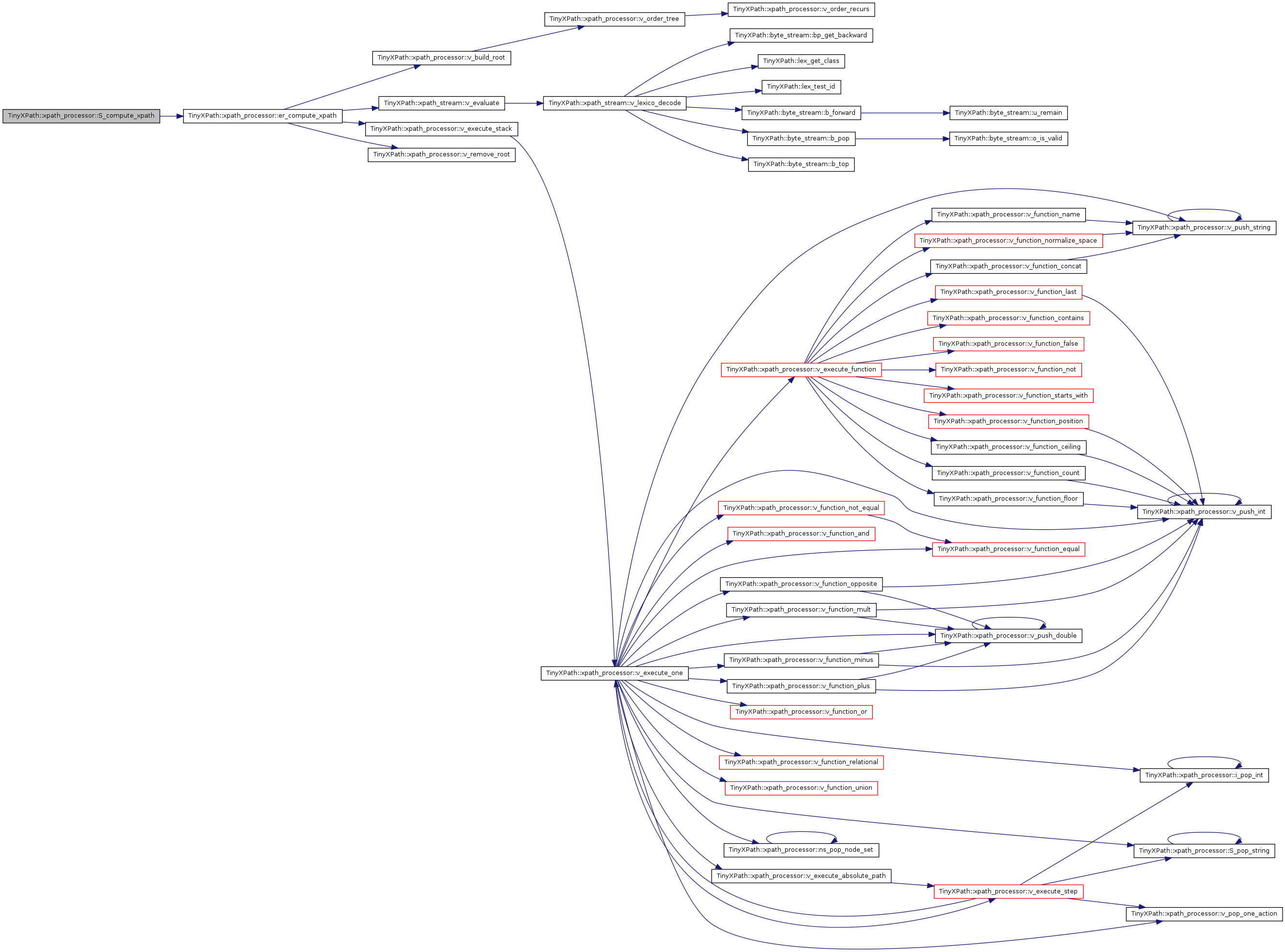
| int xpath_processor::i_compute_xpath | ( | ) |
Compute an XPath expression and return the result as an integer.
References er_compute_xpath().
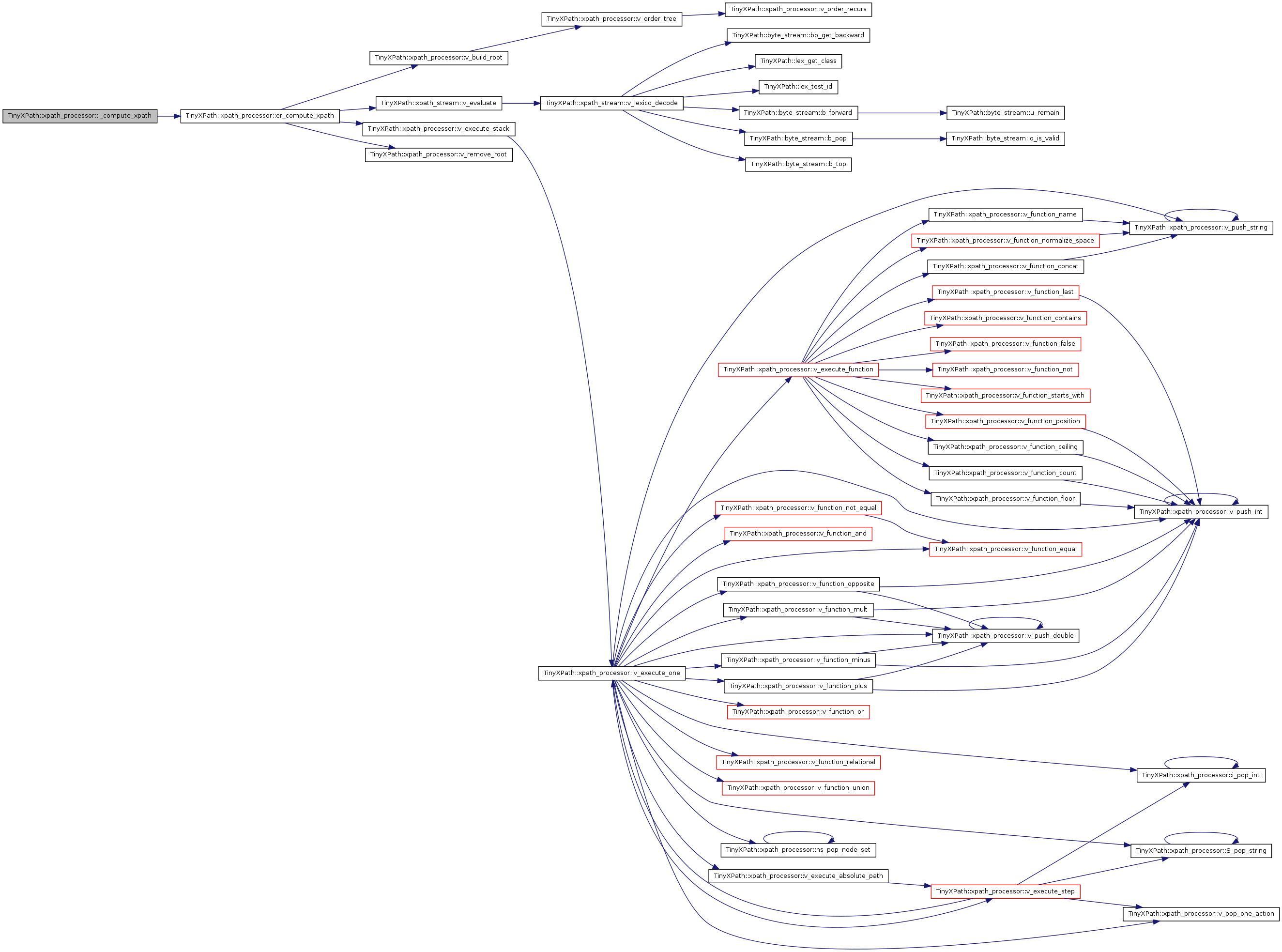
| bool xpath_processor::o_compute_xpath | ( | ) |
| double xpath_processor::d_compute_xpath | ( | ) |
| unsigned xpath_processor::u_compute_xpath_node_set | ( | ) |
Compute an XPath expression, and return the number of nodes in the resulting node set.
Returns 0 if the result is not a node set
References TinyXPath::e_node_set, er_compute_xpath(), and er_result.
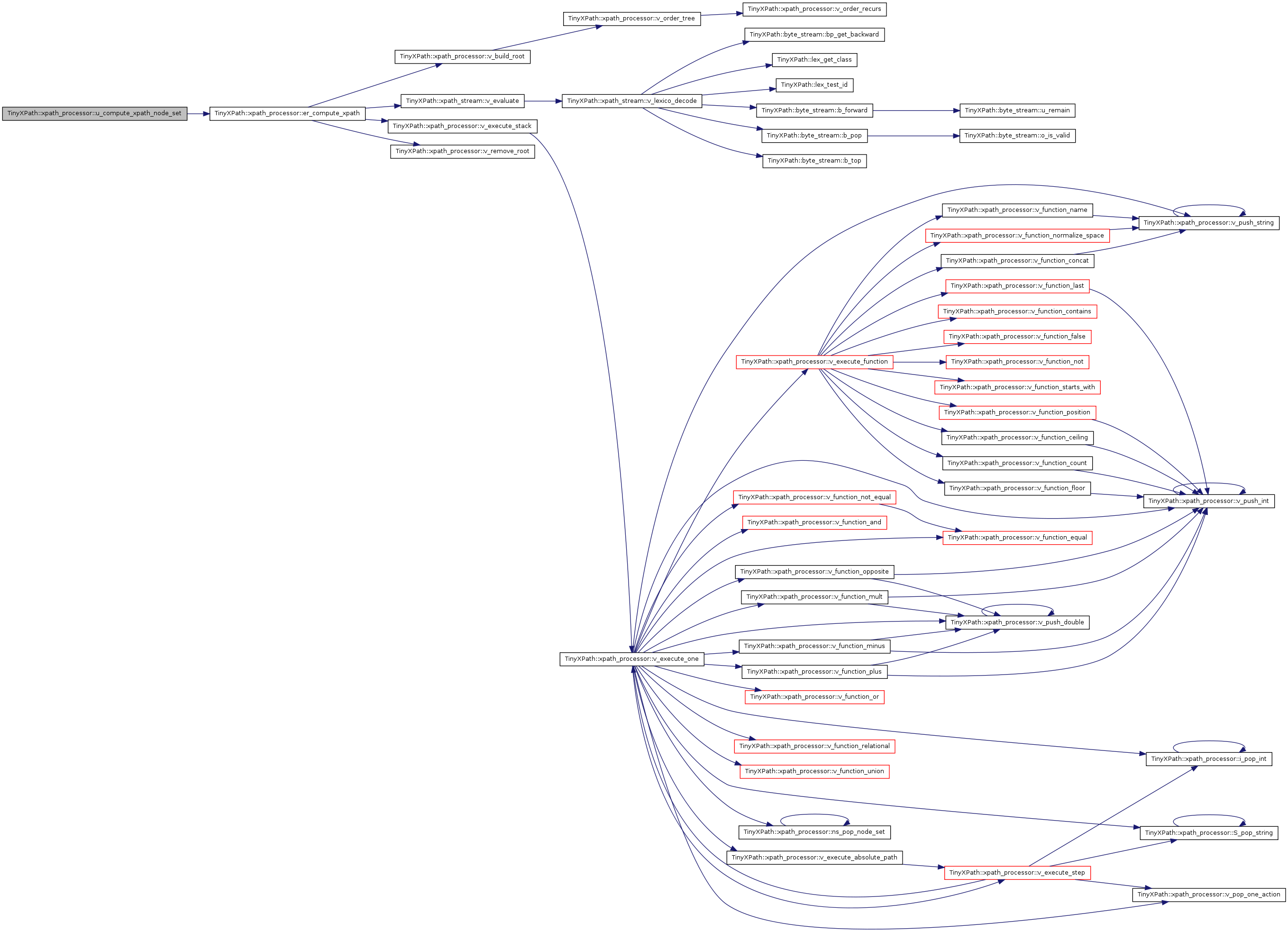
| void xpath_processor::v_get_xpath_base | ( | unsigned | u_order, | |
| const TiXmlBase *& | XBp_res, | |||
| bool & | o_attrib | |||
| ) |
Get one of the XML nodes from the resulting node set. Can only be used after a call to u_compute_xpath_node_set.
- Parameters:
-
u_order Order of the node. Must be between 0 and the number of nodes - 1 XBp_res Output node o_attrib True if the output node is an attribute, false if it's a TiXmlNode
References TinyXPath::e_node_set, and er_result.
Referenced by XAp_get_xpath_attribute(), and XNp_get_xpath_node().

| TiXmlNode * xpath_processor::XNp_get_xpath_node | ( | unsigned | u_order | ) |
Retrieves an XPath node from the node set. This assumes you know it's not an attribute.
- Parameters:
-
u_order Order of the node. Must be between 0 and the number of nodes - 1
References v_get_xpath_base().

| TiXmlAttribute * xpath_processor::XAp_get_xpath_attribute | ( | unsigned | u_order | ) |
Retrieves an XPath attribute from the node set. This assumes you know it's an attribute.
- Parameters:
-
u_order Order of the node. Must be between 0 and the number of nodes - 1
References v_get_xpath_base().

| void xpath_processor::v_action | ( | xpath_construct | xc_rule, | |
| unsigned | u_sub, | |||
| unsigned | u_variable, | |||
| const char * | cp_literal | |||
| ) | [protected, virtual] |
Callback from the XPath decoder : a rule has to be applied.
- Parameters:
-
xc_rule XPath Rule u_sub Rule sub number u_variable Parameter, depends on the rule cp_literal Input literal, depends on the rule
Implements TinyXPath::xpath_stream.
References as_action_store.
| int xpath_processor::i_get_action_counter | ( | ) | [protected, virtual] |
Internal use. Retrieves the current action counter.
Implements TinyXPath::xpath_stream.
References as_action_store.
| void xpath_processor::v_execute_stack | ( | ) | [protected] |
Internal use. Executes the XPath expression. The executions starts at the end of the as_action_store list.
References as_action_store, v_execute_one(), and TinyXPath::xpath_expr.
Referenced by er_compute_xpath().
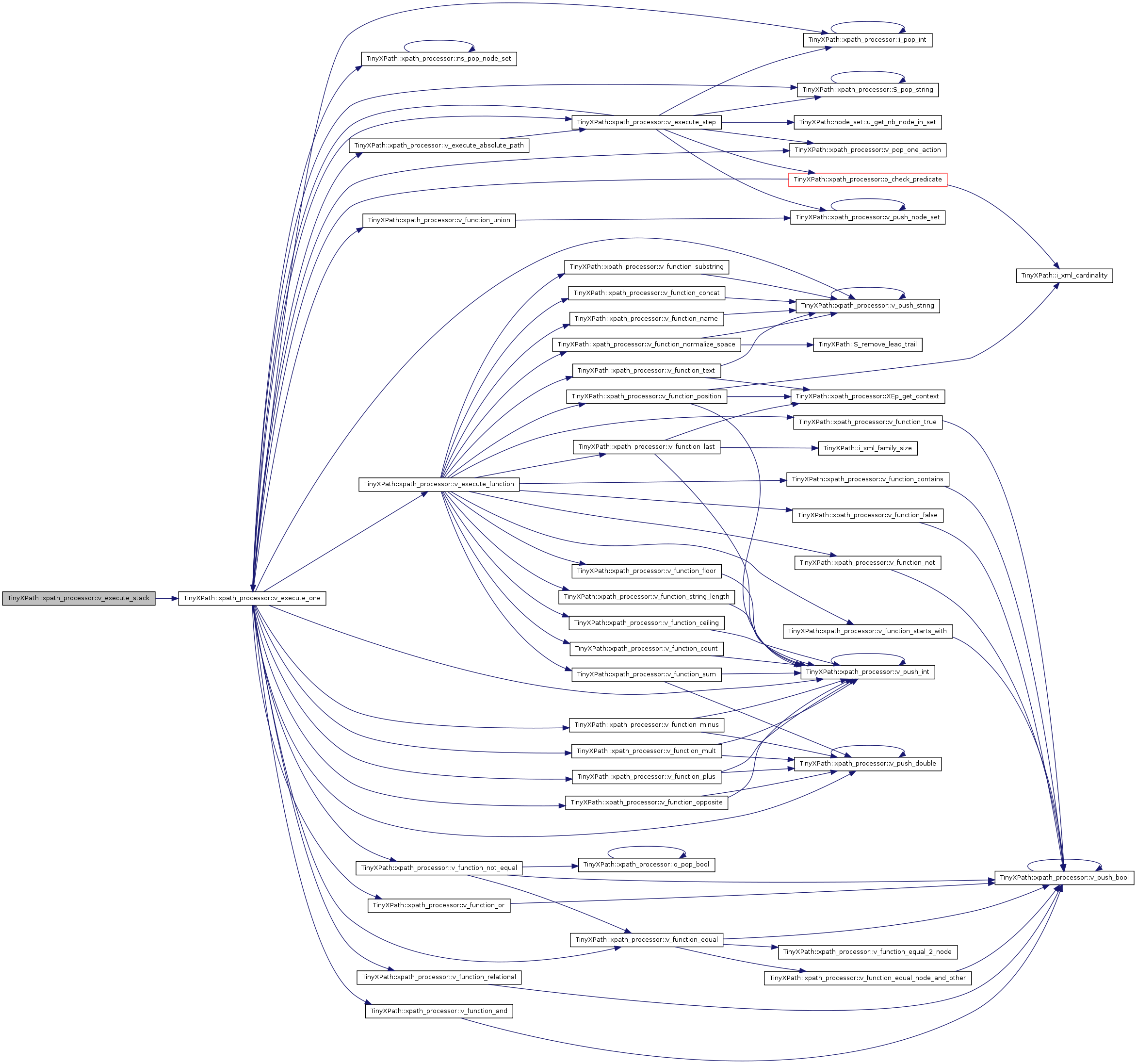

| void xpath_processor::v_pop_one_action | ( | xpath_construct & | xc_action, | |
| unsigned & | u_sub, | |||
| unsigned & | u_ref, | |||
| TiXmlString & | S_literal | |||
| ) | [protected] |
Retrieves one quadruplet from the action placeholder.
- Parameters:
-
xc_action Next rule on placeholder u_sub Sub rule u_ref Rule optional parameter S_literal Rule optional string
References as_action_store.
Referenced by v_execute_one(), and v_execute_step().

| void xpath_processor::v_execute_one | ( | xpath_construct | xc_rule, | |
| bool | o_skip_only | |||
| ) | [protected] |
Executes one XPath rule.
Compute each argument, and store them in a temporary list
- Parameters:
-
xc_rule Rule number o_skip_only True if we only need to skip rules and not act on the data stack
References TinyXPath::e_node_set, i_pop_int(), ns_pop_node_set(), S_pop_string(), TIXML_STRING, v_execute_absolute_path(), v_execute_function(), v_execute_step(), v_function_and(), v_function_equal(), v_function_minus(), v_function_mult(), v_function_not_equal(), v_function_opposite(), v_function_or(), v_function_plus(), v_function_relational(), v_function_union(), v_pop_one_action(), v_push_double(), v_push_int(), v_push_string(), TinyXPath::xpath_absolute_location_path, TinyXPath::xpath_absolute_location_path_abbrev, TinyXPath::xpath_absolute_location_path_slash, TinyXPath::xpath_absolute_location_path_slash_rel, TinyXPath::xpath_additive_expr, TinyXPath::xpath_additive_expr_minus, TinyXPath::xpath_additive_expr_more_minus, TinyXPath::xpath_additive_expr_more_plus, TinyXPath::xpath_additive_expr_plus, TinyXPath::xpath_additive_expr_simple, TinyXPath::xpath_and_expr, TinyXPath::xpath_and_expr_and, TinyXPath::xpath_and_expr_simple, TinyXPath::xpath_argument, TinyXPath::xpath_axis_name, TinyXPath::xpath_axis_specifier, TinyXPath::xpath_axis_specifier_at, TinyXPath::xpath_axis_specifier_axis_name, TinyXPath::xpath_axis_specifier_empty, TinyXPath::xpath_equality_expr, TinyXPath::xpath_equality_expr_equal, TinyXPath::xpath_equality_expr_not_equal, TinyXPath::xpath_equality_expr_simple, TinyXPath::xpath_expr, TinyXPath::xpath_filter_expr, TinyXPath::xpath_filter_expr_predicate, TinyXPath::xpath_filter_expr_primary, TinyXPath::xpath_function_call, TinyXPath::xpath_location_path, TinyXPath::xpath_location_path_abs, TinyXPath::xpath_location_path_rel, TinyXPath::xpath_multiplicative_expr, TinyXPath::xpath_multiplicative_expr_div, TinyXPath::xpath_multiplicative_expr_mod, TinyXPath::xpath_multiplicative_expr_simple, TinyXPath::xpath_multiplicative_expr_star, TinyXPath::xpath_name_test, TinyXPath::xpath_name_test_ncname, TinyXPath::xpath_name_test_qname, TinyXPath::xpath_name_test_star, TinyXPath::xpath_node_test, TinyXPath::xpath_node_test_name_test, TinyXPath::xpath_node_test_pi, TinyXPath::xpath_node_test_pi_lit, TinyXPath::xpath_node_test_reserved_keyword, TinyXPath::xpath_or_expr, TinyXPath::xpath_or_expr_or, TinyXPath::xpath_or_expr_simple, TinyXPath::xpath_path_expr, TinyXPath::xpath_path_expr_2_slash, TinyXPath::xpath_path_expr_filter, TinyXPath::xpath_path_expr_location_path, TinyXPath::xpath_path_expr_slash, TinyXPath::xpath_predicate, TinyXPath::xpath_predicate_expr, TinyXPath::xpath_primary_expr, TinyXPath::xpath_primary_expr_function_call, TinyXPath::xpath_primary_expr_literal, TinyXPath::xpath_primary_expr_number, TinyXPath::xpath_primary_expr_paren_expr, TinyXPath::xpath_primary_expr_variable, TinyXPath::xpath_relational_expr, TinyXPath::xpath_relational_expr_gt, TinyXPath::xpath_relational_expr_gte, TinyXPath::xpath_relational_expr_lt, TinyXPath::xpath_relational_expr_lte, TinyXPath::xpath_relational_expr_simple, TinyXPath::xpath_relative_location_path, TinyXPath::xpath_relative_location_path_rel_double_slash_step, TinyXPath::xpath_relative_location_path_rel_step, TinyXPath::xpath_relative_location_path_step, TinyXPath::xpath_unary_expr, TinyXPath::xpath_unary_expr_minus, TinyXPath::xpath_unary_expr_simple, TinyXPath::xpath_union_expr, TinyXPath::xpath_union_expr_simple, TinyXPath::xpath_union_expr_union, TinyXPath::xpath_variable_reference, TinyXPath::xpath_xml_local_part, TinyXPath::xpath_xml_prefix, TinyXPath::xpath_xml_q_name, TinyXPath::xpath_xml_q_name_colon, TinyXPath::xpath_xml_q_name_simple, and xs_stack.
Referenced by o_check_predicate(), v_execute_stack(), and v_execute_step().
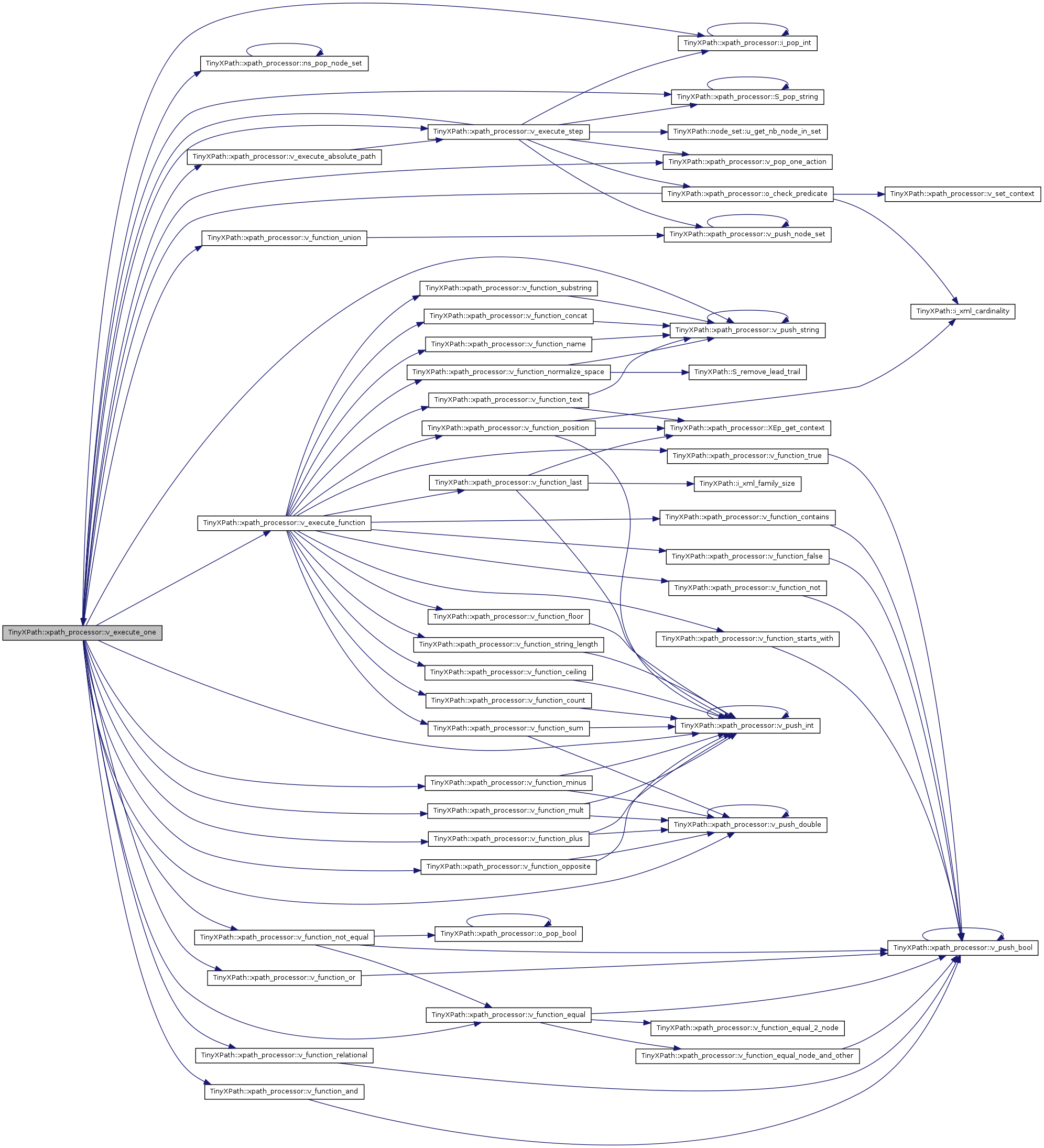

| void xpath_processor::v_execute_absolute_path | ( | unsigned | u_action_position, | |
| bool | o_with_rel, | |||
| bool | o_everywhere | |||
| ) | [protected] |
Execute a full set of absolute/relative/relative/.. computation.
- Parameters:
-
u_action_position Position of the placeholder after the rule o_with_rel true if there is some relative path o_everywhere true if it's a '//' path
References as_action_store, TIXML_STRING, v_execute_step(), and TinyXPath::xpath_relative_location_path.
Referenced by v_execute_one().
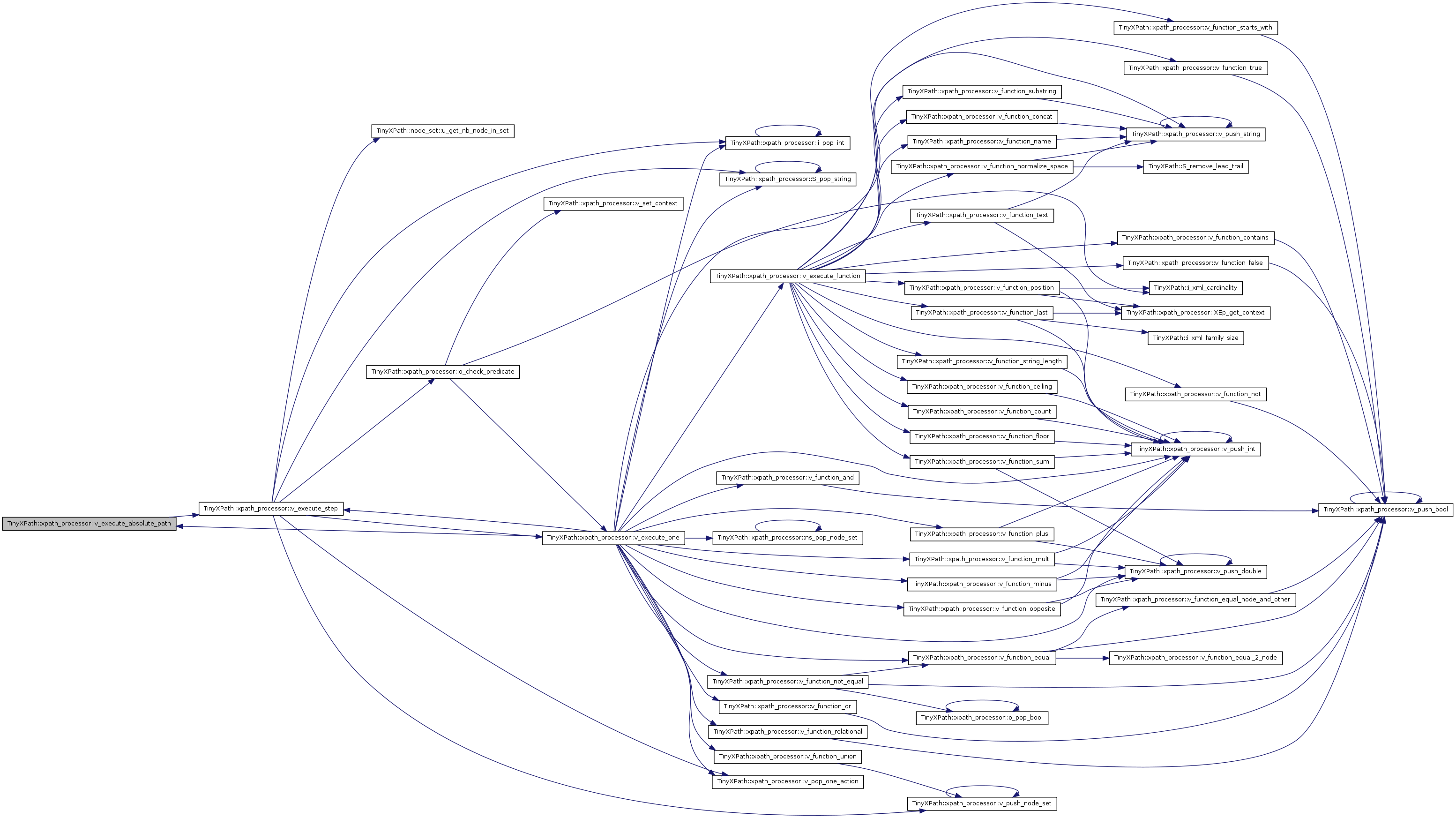

| void xpath_processor::v_execute_step | ( | int & | i_relative_action, | |
| bool | o_skip_only | |||
| ) | [protected] |
One step execution.
Initialize the source node set if it's the first step of a path
- Parameters:
-
i_relative_action Path position : -1 if first in a '//' path, 0 if first in a '/' path, > 0 if followers
References as_action_store, TiXmlNode::COMMENT, TiXmlNode::ELEMENT, i_pop_int(), TinyXPath::lex_ancestor, TinyXPath::lex_ancestor_or_self, TinyXPath::lex_attribute, TinyXPath::lex_child, TinyXPath::lex_comment, TinyXPath::lex_descendant, TinyXPath::lex_descendant_or_self, TinyXPath::lex_following, TinyXPath::lex_following_sibling, TinyXPath::lex_node, TinyXPath::lex_parent, TinyXPath::lex_preceding, TinyXPath::lex_preceding_sibling, TinyXPath::lex_self, TinyXPath::lex_text, o_check_predicate(), S_pop_string(), TiXmlNode::TEXT, TIXML_STRING, TinyXPath::node_set::u_get_nb_node_in_set(), v_execute_one(), v_pop_one_action(), v_push_node_set(), XEp_context, XEp_root, TinyXPath::xpath_axis_specifier, TinyXPath::xpath_node_test, TinyXPath::xpath_predicate, and xs_stack.
Referenced by v_execute_absolute_path(), and v_execute_one().
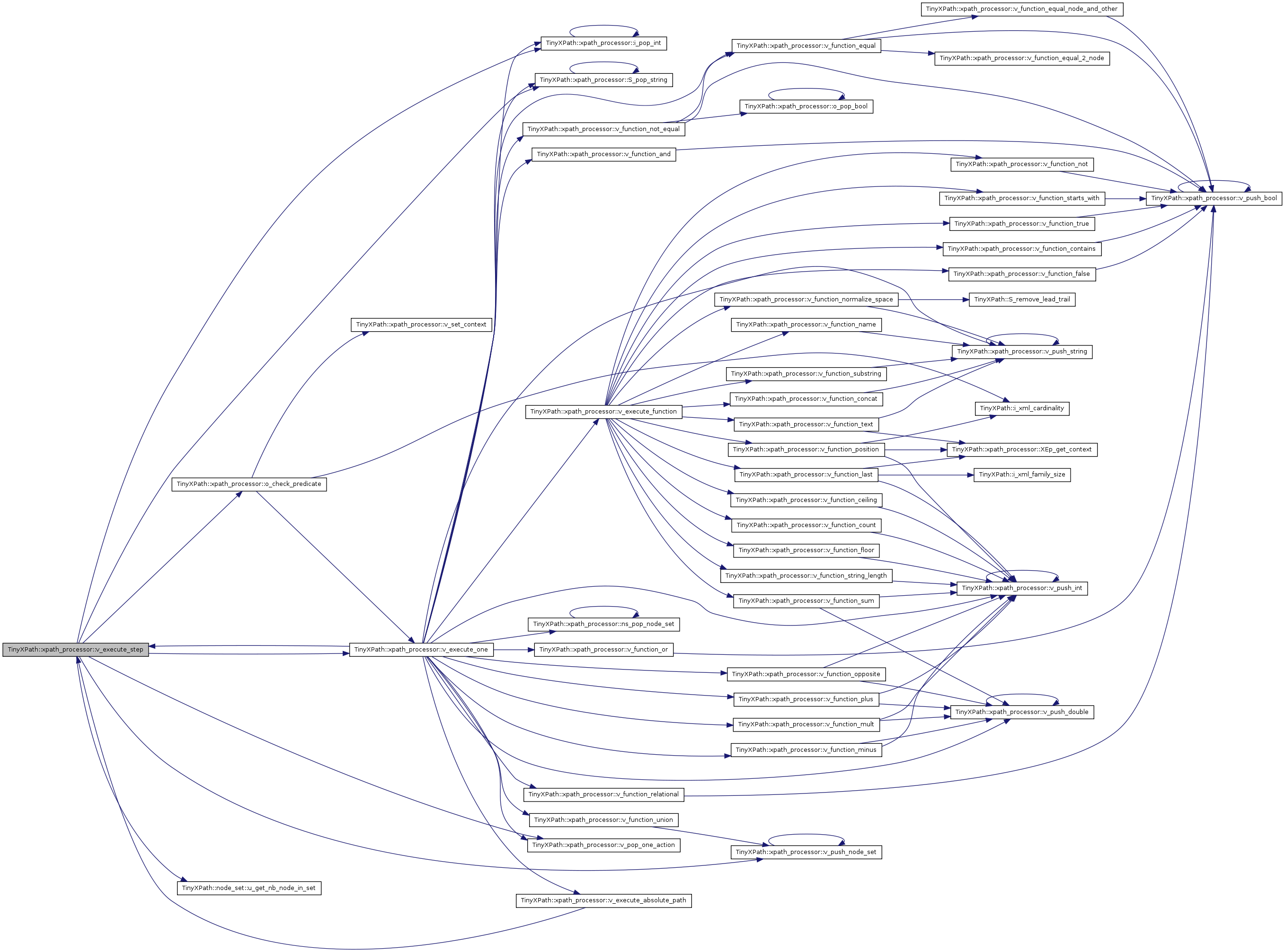

| bool xpath_processor::o_check_predicate | ( | TiXmlElement * | XEp_child, | |
| bool | o_by_name | |||
| ) | [protected] |
Spec extract :
A PredicateExpr is evaluated by evaluating the Expr and converting the result to a boolean. If the result is a number, the result will be converted to true if the number is equal to the context position and will be converted to false otherwise; if the result is not a number, then the result will be converted as if by a call to the boolean function. Thus a location path para[3] is equivalent to para[position()=3].
References TinyXPath::e_double, TinyXPath::e_int, TinyXPath::i_xml_cardinality(), v_execute_one(), v_set_context(), TinyXPath::xpath_predicate, and xs_stack.
Referenced by v_execute_step().
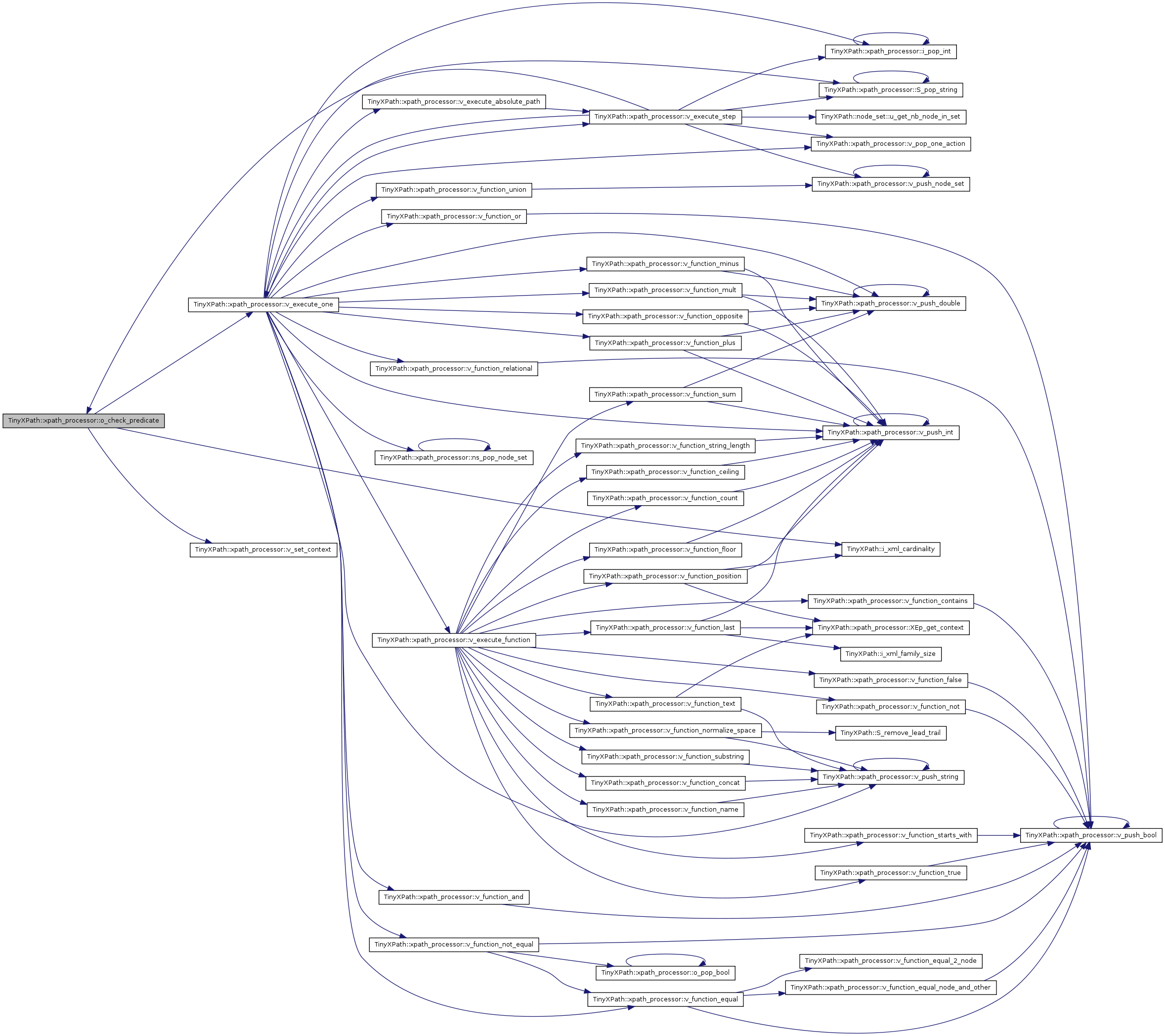

| void xpath_processor::v_execute_function | ( | TiXmlString & | S_name, | |
| unsigned | u_nb_arg, | |||
| expression_result ** | erpp_arg | |||
| ) | [protected] |
Execute an XPath function. The arguments are in normal order in erpp_arg
Calls one of the following :
- v_function_ceiling
- v_function_concat
- v_function_contains
- v_function_count
- v_function_false
- v_function_floor
- v_function_last
- v_function_name
- v_function_normalize_space
- v_function_not
- v_function_position
- v_function_starts_with
- v_function_string_length
- v_function_substring
- v_function_sum
- v_function_true
- Parameters:
-
S_name Function name u_nb_arg Nb of arguments erpp_arg Argument list
References v_function_ceiling(), v_function_concat(), v_function_contains(), v_function_count(), v_function_false(), v_function_floor(), v_function_last(), v_function_name(), v_function_normalize_space(), v_function_not(), v_function_position(), v_function_starts_with(), v_function_string_length(), v_function_substring(), v_function_sum(), v_function_text(), and v_function_true().
Referenced by v_execute_one().


| void xpath_processor::v_function_ceiling | ( | unsigned | u_nb_arg, | |
| expression_result ** | erpp_arg | |||
| ) | [protected] |
XPath ceiling function.
- Parameters:
-
u_nb_arg Nb of arguments erpp_arg Argument list
References TinyXPath::e_bool, TinyXPath::e_double, TinyXPath::e_int, and v_push_int().
Referenced by v_execute_function().


| void xpath_processor::v_function_concat | ( | unsigned | u_nb_arg, | |
| expression_result ** | erpp_arg | |||
| ) | [protected] |
XPath concat function.
- Parameters:
-
u_nb_arg Nb of arguments erpp_arg Argument list
References TIXML_STRING, and v_push_string().
Referenced by v_execute_function().


| void xpath_processor::v_function_contains | ( | unsigned | u_nb_arg, | |
| expression_result ** | erpp_arg | |||
| ) | [protected] |
XPath contains function.
- Parameters:
-
u_nb_arg Nb of arguments erpp_arg Argument list
References TIXML_STRING, and v_push_bool().
Referenced by v_execute_function().


| void xpath_processor::v_function_count | ( | unsigned | u_nb_arg, | |
| expression_result ** | erpp_arg | |||
| ) | [protected] |
XPath count function.
- Parameters:
-
u_nb_arg Nb of arguments erpp_arg Argument list
References TinyXPath::e_node_set, and v_push_int().
Referenced by v_execute_function().


| void xpath_processor::v_function_false | ( | unsigned | u_nb_arg, | |
| expression_result ** | erpp_arg | |||
| ) | [protected] |
XPath false function.
- Parameters:
-
u_nb_arg Nb of arguments erpp_arg Argument list
References v_push_bool().
Referenced by v_execute_function().


| void xpath_processor::v_function_floor | ( | unsigned | u_nb_arg, | |
| expression_result ** | erpp_arg | |||
| ) | [protected] |
XPath floor function.
- Parameters:
-
u_nb_arg Nb of arguments erpp_arg Argument list
References TinyXPath::e_bool, TinyXPath::e_double, TinyXPath::e_int, and v_push_int().
Referenced by v_execute_function().


| void xpath_processor::v_function_last | ( | unsigned | u_nb_arg, | |
| expression_result ** | erpp_arg | |||
| ) | [protected] |
XPath last function.
- Parameters:
-
u_nb_arg Nb of arguments erpp_arg Argument list
References TinyXPath::i_xml_family_size(), v_push_int(), XEp_context, and XEp_get_context().
Referenced by v_execute_function().


| void xpath_processor::v_function_name | ( | unsigned | u_nb_arg, | |
| expression_result ** | erpp_arg | |||
| ) | [protected] |
XPath name function.
- Parameters:
-
u_nb_arg Nb of arguments erpp_arg Argument list
References TinyXPath::e_node_set, Name, TIXML_STRING, and v_push_string().
Referenced by v_execute_function().


| void xpath_processor::v_function_normalize_space | ( | unsigned | u_nb_arg, | |
| expression_result ** | erpp_arg | |||
| ) | [protected] |
XPath normalize-space function.
- Parameters:
-
u_nb_arg Nb of arguments erpp_arg Argument list
References TinyXPath::S_remove_lead_trail(), TIXML_STRING, and v_push_string().
Referenced by v_execute_function().


| void xpath_processor::v_function_not | ( | unsigned | u_nb_arg, | |
| expression_result ** | erpp_arg | |||
| ) | [protected] |
XPath not function.
- Parameters:
-
u_nb_arg Nb of arguments erpp_arg Argument list
References v_push_bool().
Referenced by v_execute_function().


| void xpath_processor::v_function_position | ( | unsigned | u_nb_arg, | |
| expression_result ** | erpp_arg | |||
| ) | [protected] |
XPath position function.
- Parameters:
-
u_nb_arg Nb of arguments erpp_arg Argument list
References TinyXPath::i_xml_cardinality(), o_is_context_by_name, v_push_int(), XEp_context, and XEp_get_context().
Referenced by v_execute_function().


| void xpath_processor::v_function_starts_with | ( | unsigned | u_nb_arg, | |
| expression_result ** | erpp_arg | |||
| ) | [protected] |
XPath starts-with function.
- Parameters:
-
u_nb_arg Nb of arguments erpp_arg Argument list
References TIXML_STRING, and v_push_bool().
Referenced by v_execute_function().


| void xpath_processor::v_function_string_length | ( | unsigned | u_nb_arg, | |
| expression_result ** | erpp_arg | |||
| ) | [protected] |
XPath sttring-length function.
- Parameters:
-
u_nb_arg Nb of arguments erpp_arg Argument list
References TIXML_STRING, and v_push_int().
Referenced by v_execute_function().


| void xpath_processor::v_function_substring | ( | unsigned | u_nb_arg, | |
| expression_result ** | erpp_arg | |||
| ) | [protected] |
XPath substring function
Standard excerpt:
The substring function returns the substring of the first argument starting at the position specified in the second argument with length specified in the third argument. For example, substring("12345",2,3) returns "234". If the third argument is not specified, it returns the substring starting at the position specified in the second argument and continuing to the end of the string. For example, substring("12345",2) returns "2345".
- Parameters:
-
u_nb_arg Nb of arguments erpp_arg Argument list
References TIXML_STRING, and v_push_string().
Referenced by v_execute_function().


| void xpath_processor::v_function_sum | ( | unsigned | u_nb_arg, | |
| expression_result ** | erpp_arg | |||
| ) | [protected] |
XPath sum function
Standard exerpt :
The sum function returns the sum, for each node in the argument node-set, of the result of converting the string-values of the node to a number.
- Parameters:
-
u_nb_arg Nb of arguments erpp_arg Argument list
References TinyXPath::e_node_set, v_push_double(), and v_push_int().
Referenced by v_execute_function().


| void xpath_processor::v_function_text | ( | unsigned | u_nb_arg, | |
| expression_result ** | erpp_arg | |||
| ) | [protected] |
XPath text function.
- Parameters:
-
u_nb_arg Nb of arguments erpp_arg Argument list
References TiXmlNode::TEXT, TIXML_STRING, v_push_string(), XEp_context, and XEp_get_context().
Referenced by v_execute_function().


| void xpath_processor::v_function_true | ( | unsigned | u_nb_arg, | |
| expression_result ** | erpp_arg | |||
| ) | [protected] |
XPath true function.
- Parameters:
-
u_nb_arg Nb of arguments erpp_arg Argument list
References v_push_bool().
Referenced by v_execute_function().


| void xpath_processor::v_function_equal | ( | expression_result ** | erpp_arg | ) | [protected] |
This function is for internal use : evaluation of an equality expression
Standard excerpt :
If both objects to be compared are node-sets, then the comparison will be true if and only if there is a node in the first node-set and a node in the second node-set such that the result of performing the comparison on the string-values of the two nodes is true.
If one object to be compared is a node-set and the other is a number, then the comparison will be true if and only if there is a node in the node-set such that the result of performing the comparison on the number to be compared and on the result of converting the string-value of that node to a number using the number function is true.
If one object to be compared is a node-set and the other is a string, then the comparison will be true if and only if there is a node in the node-set such that the result of performing the comparison on the string-value of the node and the other string is true.
If one object to be compared is a node-set and the other is a boolean, then the comparison will be true if and only if the result of performing the comparison on the boolean and on the result of converting the node-set to a boolean using the boolean function is true.
When neither object to be compared is a node-set and the operator is = or !=, then the objects are compared by converting them to a common type as follows and then comparing them.
- If at least one object to be compared is a boolean, then each object to be compared is converted to a boolean as if by applying the boolean function.
- Otherwise, if at least one object to be compared is a number, then each object to be compared is converted to a number as if by applying the number function.
- Otherwise, both objects to be compared are converted to strings as if by applying the string function. The = comparison will be true if and only if the objects are equal; the != comparison will be true if and only if the objects are not equal.
- Numbers are compared for equality according to IEEE 754.
- Two booleans are equal if either both are true or both are false.
- Two strings are equal if and only if they consist of the same sequence of UCS characters.
References TinyXPath::e_bool, TinyXPath::e_double, TinyXPath::e_int, TinyXPath::e_node_set, v_function_equal_2_node(), v_function_equal_node_and_other(), and v_push_bool().
Referenced by v_execute_one(), and v_function_not_equal().


| void xpath_processor::v_function_not_equal | ( | expression_result ** | erpp_arg | ) | [protected] |
This function is for internal use : evaluation of a non-equality expression.
References o_pop_bool(), v_function_equal(), and v_push_bool().
Referenced by v_execute_one().


| void xpath_processor::v_function_equal_node_and_other | ( | expression_result * | erp_node_set, | |
| expression_result * | erp_non | |||
| ) | [protected] |
Utility function that evaluates the equality between a node set and a non-node set
Standard excerpt :
If one object to be compared is a node-set and the other is a number, then the comparison will be true if and only if there is a node in the node-set such that the result of performing the comparison on the number to be compared and on the result of converting the string-value of that node to a number using the number function is true.
If one object to be compared is a node-set and the other is a string, then the comparison will be true if and only if there is a node in the node-set such that the result of performing the comparison on the string-value of the node and the other string is true.
If one object to be compared is a node-set and the other is a boolean, then the comparison will be true if and only if the result of performing the comparison on the boolean and on the result of converting the node-set to a boolean using the boolean function is true.
References TinyXPath::e_bool, TinyXPath::e_double, TinyXPath::e_int, TinyXPath::e_string, and v_push_bool().
Referenced by v_function_equal().


| void xpath_processor::v_function_equal_2_node | ( | expression_result * | erp_node_set_, | |
| expression_result * | erp_node_set_2 | |||
| ) | [protected] |
- Todo:
- : Implement this function. We don't compare 2 node sets yet
Referenced by v_function_equal().

Union function.
References v_push_node_set().
Referenced by v_execute_one().


| void xpath_processor::v_function_minus | ( | expression_result ** | erpp_arg | ) | [protected] |
XPath - function.
References TinyXPath::e_double, v_push_double(), and v_push_int().
Referenced by v_execute_one().


| void xpath_processor::v_function_plus | ( | expression_result ** | erpp_arg | ) | [protected] |
XPath + function.
References TinyXPath::e_double, v_push_double(), and v_push_int().
Referenced by v_execute_one().


| void xpath_processor::v_function_or | ( | expression_result ** | erpp_arg | ) | [protected] |
XPath or function.
References v_push_bool().
Referenced by v_execute_one().


| void xpath_processor::v_function_and | ( | expression_result ** | erpp_arg | ) | [protected] |
XPath and function.
References v_push_bool().
Referenced by v_execute_one().


| void xpath_processor::v_function_relational | ( | expression_result ** | erpp_arg, | |
| unsigned | u_sub | |||
| ) | [protected] |
XPath relational comparison function.
References TinyXPath::e_double, v_push_bool(), TinyXPath::xpath_relational_expr_gt, TinyXPath::xpath_relational_expr_gte, TinyXPath::xpath_relational_expr_lt, and TinyXPath::xpath_relational_expr_lte.
Referenced by v_execute_one().


| void xpath_processor::v_function_opposite | ( | ) | [protected] |
This function, because it only operates on one argument retrieves it himself from the stack
It computes the mathematical opposite
References TinyXPath::e_double, v_push_double(), v_push_int(), and xs_stack.
Referenced by v_execute_one().


| void xpath_processor::v_function_mult | ( | expression_result ** | erpp_arg, | |
| unsigned | u_sub | |||
| ) | [protected] |
XPath * function (arithmetic).
References TinyXPath::e_double, v_push_double(), v_push_int(), TinyXPath::xpath_multiplicative_expr_div, TinyXPath::xpath_multiplicative_expr_mod, and TinyXPath::xpath_multiplicative_expr_star.
Referenced by v_execute_one().


| void xpath_processor::v_order_tree | ( | ) | [protected] |
flag that says if the tree has been ordered already. This is a rather slow process, so we only do it if needed
Order the tree : assign an integer to all nodes based on the document order
Right now, tinyxml doesn't have a user value associated to attributes ... arrrgh. We order everything else, and will have to compute attributes order on demand
References v_order_recurs(), and XEp_root.
Referenced by v_build_root().


| void xpath_processor::v_order_recurs | ( | TiXmlNode * | Np_base, | |
| int & | i_current | |||
| ) | [protected] |
Recursive ordering of an XML tree according to XPath's document order.
The result is stored as an integer in the void * pointer managed by TiXmlNode::SetUserData / TiXmlNode::GetUserData
Referenced by v_order_tree().

| void TinyXPath::xpath_processor::v_push_int | ( | int | i_val, | |
| const char * | cp_comment = "" | |||
| ) | [inline, protected] |
References v_push_int(), and xs_stack.
Referenced by v_execute_one(), v_function_ceiling(), v_function_count(), v_function_floor(), v_function_last(), v_function_minus(), v_function_mult(), v_function_opposite(), v_function_plus(), v_function_position(), v_function_string_length(), v_function_sum(), and v_push_int().


| void TinyXPath::xpath_processor::v_push_string | ( | TiXmlString | S_val | ) | [inline, protected] |
References v_push_string(), and xs_stack.
Referenced by v_execute_one(), v_function_concat(), v_function_name(), v_function_normalize_space(), v_function_substring(), v_function_text(), and v_push_string().


| void TinyXPath::xpath_processor::v_push_bool | ( | bool | o_val | ) | [inline, protected] |
References v_push_bool(), and xs_stack.
Referenced by v_function_and(), v_function_contains(), v_function_equal(), v_function_equal_node_and_other(), v_function_false(), v_function_not(), v_function_not_equal(), v_function_or(), v_function_relational(), v_function_starts_with(), v_function_true(), and v_push_bool().


| void TinyXPath::xpath_processor::v_push_double | ( | double | d_val | ) | [inline, protected] |
References v_push_double(), and xs_stack.
Referenced by v_execute_one(), v_function_minus(), v_function_mult(), v_function_opposite(), v_function_plus(), v_function_sum(), and v_push_double().


| void TinyXPath::xpath_processor::v_push_node_set | ( | node_set * | nsp_val | ) | [inline, protected] |
References v_push_node_set(), and xs_stack.
Referenced by v_execute_step(), v_function_union(), and v_push_node_set().


| bool TinyXPath::xpath_processor::o_pop_bool | ( | ) | [inline, protected] |
References o_pop_bool(), and xs_stack.
Referenced by o_pop_bool(), and v_function_not_equal().


| int TinyXPath::xpath_processor::i_pop_int | ( | ) | [inline, protected] |
References i_pop_int(), and xs_stack.
Referenced by i_pop_int(), v_execute_one(), and v_execute_step().


| TiXmlString TinyXPath::xpath_processor::S_pop_string | ( | ) | [inline, protected] |
References S_pop_string(), and xs_stack.
Referenced by S_pop_string(), v_execute_one(), and v_execute_step().


| node_set TinyXPath::xpath_processor::ns_pop_node_set | ( | ) | [inline, protected] |
References ns_pop_node_set(), and xs_stack.
Referenced by ns_pop_node_set(), and v_execute_one().


| void xpath_processor::v_set_context | ( | TiXmlElement * | XEp_in, | |
| bool | o_by_name | |||
| ) | [protected] |
Set the current context node for predicate evaluations.
- Parameters:
-
XEp_in Context node o_by_name true if the current node search is by name, false if it's a *
References o_is_context_by_name, and XEp_context.
Referenced by o_check_predicate().

| const TiXmlElement* TinyXPath::xpath_processor::XEp_get_context | ( | ) | [inline, protected] |
References XEp_context.
Referenced by v_function_last(), v_function_position(), and v_function_text().

| void xpath_processor::v_build_root | ( | ) | [protected] |
References v_order_tree(), XEp_context, XEp_root, XNp_base, XNp_caller_next, XNp_caller_parent, and XNp_caller_prev.
Referenced by er_compute_xpath().


| void xpath_processor::v_remove_root | ( | ) | [protected] |
Remove our fake root, and restore the original relationships of the node given to us as argument
References XEp_root, XNp_base, XNp_caller_next, XNp_caller_parent, and XNp_caller_prev.
Referenced by er_compute_xpath().

Member Data Documentation
| enum { ... } TinyXPath::xpath_processor::e_error |
Referenced by er_compute_xpath().
xpath_stack TinyXPath::xpath_processor::xs_stack [protected] |
Referenced by i_get_action_counter(), v_action(), v_execute_absolute_path(), v_execute_stack(), v_execute_step(), and v_pop_one_action().
TiXmlElement* TinyXPath::xpath_processor::XEp_root [protected] |
Root, above the XML tree given as parameter to the xpath_processor object.
Referenced by er_compute_xpath(), v_build_root(), v_execute_step(), v_order_tree(), and v_remove_root().
const TiXmlElement* TinyXPath::xpath_processor::XEp_context [protected] |
Current context.
Referenced by v_build_root(), v_execute_step(), v_function_last(), v_function_position(), v_function_text(), v_set_context(), XEp_get_context(), and xpath_processor().
The result of the XPath evaluation, for further node retrieving by v_get_xpath_base.
Referenced by er_compute_xpath(), u_compute_xpath_node_set(), and v_get_xpath_base().
bool TinyXPath::xpath_processor::o_is_context_by_name [protected] |
Referenced by v_function_position(), v_set_context(), and xpath_processor().
const TiXmlNode* TinyXPath::xpath_processor::XNp_caller_parent [protected] |
Referenced by v_build_root(), and v_remove_root().
const TiXmlNode* TinyXPath::xpath_processor::XNp_caller_prev [protected] |
Referenced by v_build_root(), and v_remove_root().
const TiXmlNode* TinyXPath::xpath_processor::XNp_caller_next [protected] |
Referenced by v_build_root(), and v_remove_root().
const TiXmlNode* TinyXPath::xpath_processor::XNp_base [protected] |
Referenced by v_build_root(), v_remove_root(), and xpath_processor().
The documentation for this class was generated from the following files:

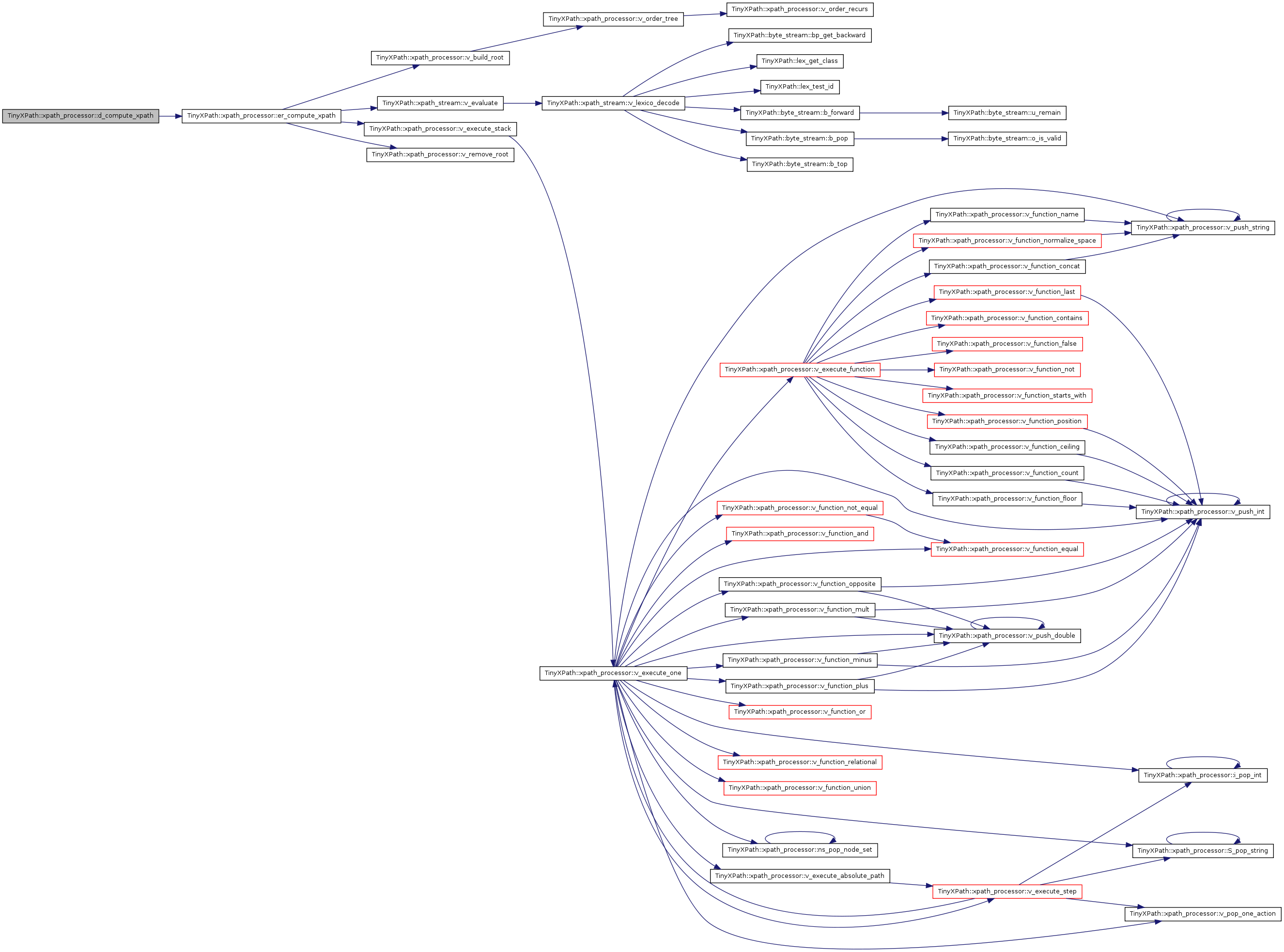
 1.7.1
1.7.1